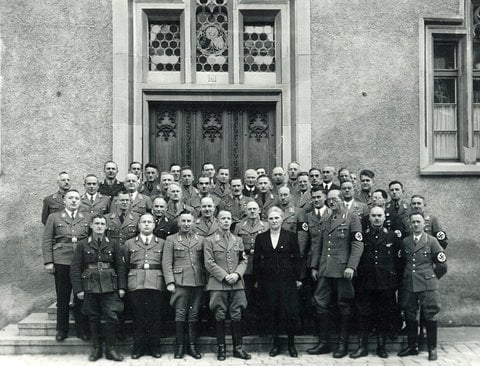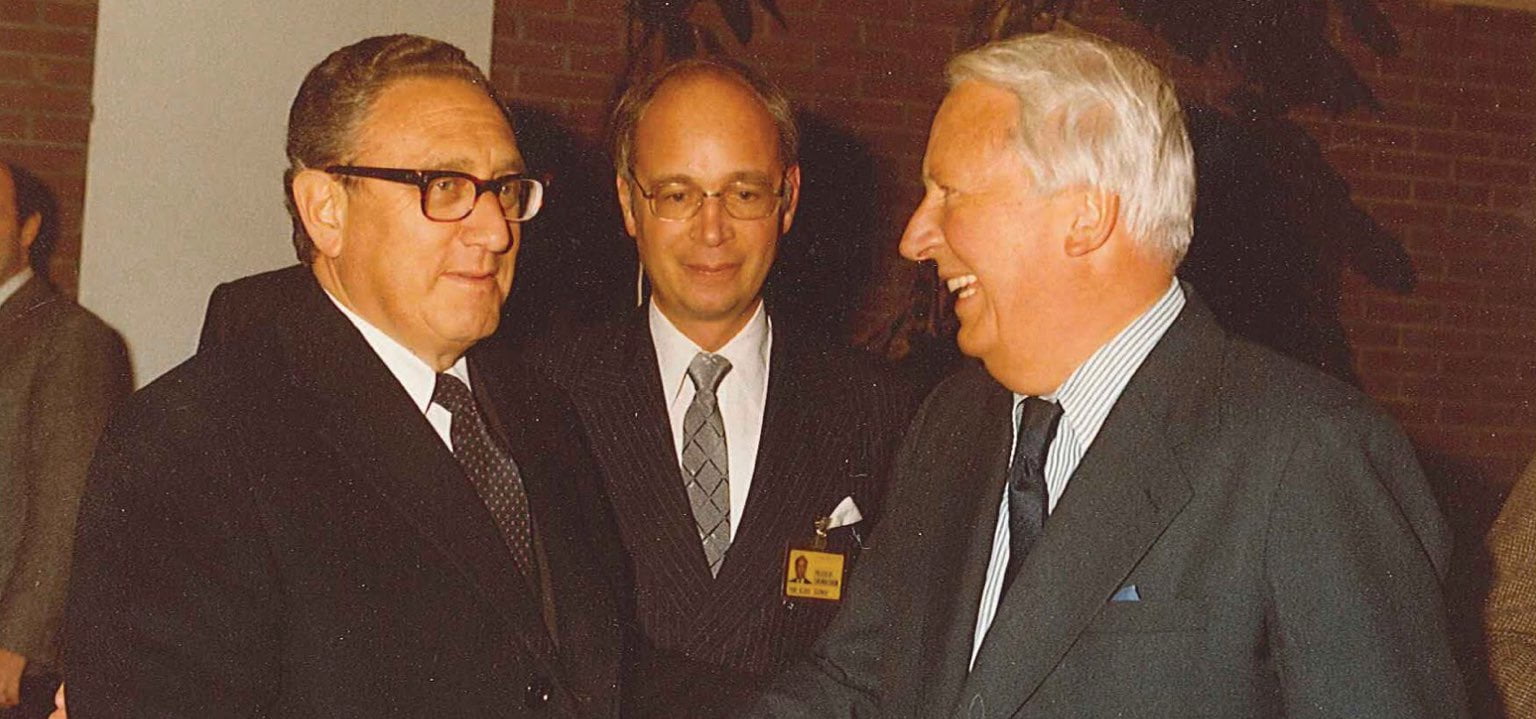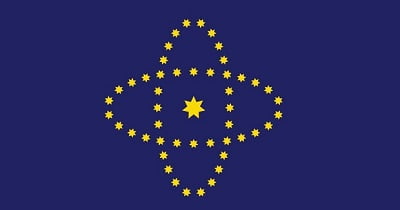The massacres which took place in Lindau, Überlingen and Ravensburg happened with the direct approval of the ruling King Sigmund and any remaining Jews were soon expelled from the region.
Ravensburg had this ban confirmed by Emperor Ferdinand I in 1559 and it was upheld, for example, in an 1804 instruction issued for the city guard, which read:
“Since the Jews are not allowed to engage in any trade or business here, no one else is allowed to enter the city by post or by carriage, The rest, however, if they have not received a permit for a longer or shorter stay from the police office, are to be removed from the city by the police station.”
Not until the 19th century were Jews able to settle legally in Ravensburg again and, even by then, their number remained so small that a synagogue was not rebuilt.
In 1858, there were only 3 Jews recorded in Ravensburg and, in 1895, this number peaked at 57. From the turn of the century until 1933, the numbers of Jews living in Ravensburg had steadily decreased until the community was only made up of 23 people.
By the start of the 1930s, there were seven main Jewish families living in Ravensburg, including the Adler, Erlanger, Harburger, Herrmann, Landauer, Rose and Sondermann families.
After the National Socialists seized power, some of the Ravensburg Jews were initially forced to emigrate, while others would later be murdered in Nazi concentration camps. Leading up to World War II, there were many public displays of hatred towards the small community of Jews in and around Ravensburg.
As early as March 13, 1933, about three weeks before the nationwide Nazi boycott of all Jewish shops in Germany, SA guards posted themselves in front of two of the five Jewish shops in Ravensburg and tried to prevent potential buyers from entering, putting up signs on one shop stating “Wohlwert closed until Aryanization”. Wohlwert’s would soon become
“Aryanised” and would be the only Jewish-owned shop to survive the Nazi pogrom. The other owners of the four large Jewish department stores in Ravensburg; Knopf; Merkur; Landauer and Wallersteiner were all forced to sell their properties to non-Jewish merchants between 1935 and 1938.
During this period, many of the Ravensburg Jews were able to flee abroad before the worst of the National Socialist persecution began. While at least eight died violently, it was reported that three Jewish citizens who lived in Ravensburg survived because of their “Aryan” spouses.
Some of the Jews who were arrested in Ravensburg during Kristallnacht were forced to march through the streets of Baden-Baden under SS guard supervision the following day and were later deported to Sachsenhausen concentration camp.
Horrific Nazi crimes against humanity took place in Ravensburg. On 1 January 1934, the “Law for the Prevention of Hereditary Diseases” came into force in Nazi Germany, meaning people with diagnosed illnesses such as dementia, schizophrenia, epilepsy, hereditary deafness, and various other mental disorders, could be legally forcibly sterilised.
In the Ravensburg City Hospital, today called Heilig-Geist Hospital, forced sterilisations were carried out beginning in April 1934. By 1936, sterilisation was the most performed medical procedure in the municipal hospital.
In the pre-war years of the 1930s leading up to the German annexation of Poland, Ravensburg’s Escher-Wyss factory, now managed directly by Klaus Schwab’s father, Eugen Schwab, continued to be the biggest employer in Ravensburg.
Not only was the factory a major employer in the town, but Hitler’s own Nazi party awarded the Escher-Wyss Ravensburg branch the title of “National Socialist Model Company” while Schwab was at the helm. The Nazis were potentially wooing the Swiss company for cooperation in the coming war, and their advances were eventually reciprocated.
Escher-Wyss Ravensburg And The War
Ravensburg was an anomaly in wartime Germany, as it was never targeted by any Allied airstrikes. The presence of the Red Cross, and a rumoured agreement with various companies including Escher-Wyss, saw the allied forces publicly agree to not target the Southern German town.
It was not classified as a significant military target throughout the war and, for that reason, the town still maintains many of its original features.
However, much darker things were afoot in Ravensburg once the war began.
Eugen Schwab continued to manage the “National Socialist Model Company” for Escher-Wyss, and the Swiss company would aid the Nazi Wermacht produce significant weapons of war as well as more basic armaments.
The Escher-Wyss company was a leader in large turbine technology for hydroelectric dams and power plants, but they also manufactured parts for German fighter planes. They were also intimately involved in much more sinister projects happening behind the scenes which, if completed, could have changed the outcome of World War II.

Western military intelligence were already aware of Escher-Wyss’ complicity and collaboration with the Nazis. There are records available from western military intelligence at the time, specifically Record Group 226 (RG 226) from the data compiled by the Office of Strategic Services (OSS), which shows the Allied forces were aware of some of the Escher-Wyss’ business dealings with the Nazis.
Within RG 226, there are three specific mentions of Escher-Wyss including:
- File number 47178 which reads: Escher-Wyss of Switzerland is working on a large order for Germany. Flame-throwers are despatched from Switzerland under the name Brennstoffbehaelter. Dated Sept. 1944.
- File number 41589 showed that the Swiss were allowing German exports to be stored in their country, a supposedly neutral nation during World War II. The entry reads: Business relations between Empresa Nacional Calvo Sotelo (ENCASO), Escher Wyss, and Mineral Celbau Gesellschaft. 1 p. July 1944; see also L 42627 Report on collaboration between the Spanish Empresa Nacional Calvo Sotelo and the German Rheinmetall Borsig, on German exports stored in Switzerland. 1 p. August 1944.
- File number 72654 claimed that: Hungary’s bauxite was formerly sent to Germany and Switzerland for refining. Then a government syndicate built an aluminium plant at Dunaalmas on the borders of Hungary. Electric power was provided; Hungary contributed coal mines, and equipment was ordered from the Swiss firm Escher-Wyss. Production began in 1941. 2 pp. May 1944.
Yet, Escher-Wyss were leaders in one blossoming field in particular, the creation of new turbine technology. The company had engineered a 14,500 HP turbine for the Norsk Hydro industrial facility’s strategically important hydroelectric plant at Vemork, near Rjukan in Norway.
The Norsk Hydro plant, part powered by Escher Wyss, was the only industrial plant under Nazi control capable of producing heavy water, an ingredient essential for making plutonium for the Nazi atomic bomb program. The Germans had put all possible resources behind the production of heavy water, but the Allied forces were aware of the potentially game-changing tech advances by the increasingly desperate Nazis.
During 1942 and 1943, the hydro plant was the target of partially successful British Commando and Norwegian Resistance raids, although heavy water production continued. The Allied forces would drop more than 400 bombs on the plant, which barely affected the operations at the sprawling facility.
In 1944, German ships attempted to transport heavy water back to Germany, but the Norwegian Resistance were able to sink the ship carrying the payload. With help from Escher-Wyss, the Nazis were almost able to change the tides of war and bring about an Axis victory.
Back in the Escher-Wyss factory in Ravensburg, Eugen Schwab had been busy putting forced labourers to work at his model Nazi company. During the years of World War II, nearly 3,600 forced labourers worked in Ravensburg, including at Escher Wyss.
According to the city archivist in Ravensburg, Andrea Schmuder, the Escher-Wyss machine factory in Ravensburg employed between 198 and 203 civil workers and POWs during the war. Karl Schweizer, a local Lindau historian, states that Escher-Wyss maintained a small special camp for forced labourers on the factory premises.
The use of masses of forced labourers in Ravensburg made it necessary to setup one of the largest recorded Nazi forced labour camps in the workshop of a former carpenter’s at Ziegelstrasse 16. At one time, the camp in question accommodated 125 French prisoners of war who were later redistributed to other camps in 1942.
The French workers were replaced by 150 Russian prisoners of war who, it was rumoured, were treated the worst out of all the POWs. One such prisoner was Zina Jakuschewa, whose work card and work book are held by the United States Holocaust Memorial Museum. Those documents identify her as a non-Jewish forced labourer assigned to Ravensburg, Germany, during 1943 and 1944.
Eugen Schwab would dutifully maintain the status quo during the war years. After all, with young Klaus Martin Schwab having been born in 1938 and his brother Urs Reiner Schwab born a few years later, Eugen would have wanted to keep his children out of harm’s way.
Klaus Martin Schwab – International Man Of Mystery
Born on 30 March 1938 in Ravensburg, Germany, Klaus Schwab was the eldest child in a normal nuclear family. Between 1945 and 1947, Klaus attended primary school in Au, Germany.
Klaus Schwab recalls in a 2006 interview with the Irish Times that:”After the war, I chaired the Franco-German regional youth association. My heroes were Adenauer, De Gasperi and De Gaulle.”
Klaus Schwab and his younger brother, Urs Reiner Schwab, were both to follow in the footsteps of their grandfather, Gottfried, and their father, Eugen, and would both initially train as machine engineers.
Klaus’s father had told the young Schwab that, if he wanted to make an impact on the world, then he should train as a Machine Engineer. This would only be the beginning of Schwab’s University credentials.
Klaus would begin studying his plethora of degrees at Spohn-Gymnasium Ravensburg between 1949 and 1957, eventually graduating from the Humanistisches Gymnasium in Ravensburg.
Between 1958 and 1962, Klaus began working with various engineering companies and, in 1962, Klaus completed his mechanical engineering studies at the Swiss Federal Institute of Technology (ETH) in Zurich with an engineering diploma. The following year, he also completed an economics course at the University of Fribourg, Switzerland. From 1963 until 1966, Klaus worked as Assistant to the Director-General of the German Machine-building Association (VDMA), Frankfurt.
In 1965, Klaus was also working on his doctorate from the ETH Zurich, writing his dissertation on: “The longer-term export credit as a business problem in mechanical engineering”. Then, in 1966, he received his Doctorate in Engineering from the Swiss Federal Institute of Technology (ETH), Zurich. At this time, Klaus’s father, Eugen Schwab, was swimming in bigger circles than he had previously swam.
After being a well known personality in Ravensburg as the Managing Director of the Escher-Wyss factory from before the war, Eugen would eventually be elected as President of the Ravensburg Chamber of Commerce.
In 1966, during the founding of the German committee for Splügen railway tunnel, Eugen Schwab defined the founding of the German committee as a project “that creates a better and faster connection for large circles in our increasingly converging Europe and thus offers new opportunities for cultural, economic and social development”.
In 1967, Klaus Schwab gained a Doctorate in Economics from the University of Fribourg, Switzerland as well as a Master of Public Administration qualification from the John F. Kennedy School of Government at Harvard in the United States. While at Harvard, Schwab was taught by Henry Kissinger, who he would later say were among the top 3-4 figures who had most influenced his thinking over the course of his entire life.

In the previously mentioned Irish Times article of 2006, Klaus talks about that period as being very important to the formation of his present idealogical thinking, stating:
“Years later, when I came back from the US after my studies at Harvard, there were two events that had a decisive triggering event on me. The first was a book by Jean-Jacques Servan-Schreiber, The American Challenge – which said Europe would lose out against the US because of Europe’s inferior management methods. The other event was – and this is relevant to Ireland – the Europe of the six became the Europe of the nine.”
These two events would help shape Klaus Schwab into a man who wanted to change the way people went about their business.
That same year, Klaus’s younger brother Urs Reiner Schwab graduated from ETH Zurich as a mechanical engineer, and Klaus Schwab went to work for his father’s old company, Escher-Wyss, soon to become Sulzer Escher-Wyss AG, Zurich, as Assistant to the Chairman to aid in the reorganisation of the merging companies. This leads us towards Klaus’s nuclear connections.
The Rise Of A Technocrat
Sulzer, a Swiss company whose origins date back to 1834, had first risen to prominence after starting to build compressors in 1906. By 1914, the family-run firm had become part of “three joint-stock companies,” one of which was the official holding company.
In the 1930s, Sulzer’s profits would suffer during the Great Depression and, like many businesses at the time, faced disruption and industrial actions from their workers.
World War II may not have affected Switzerland as much as her neighbours, but the economic boom that was to follow led to Sulzer growing in power and market dominance.
In 1966, just before the arrival of Klaus Schwab at Escher-Wyss, the Swiss turbine manufacturers signed a cooperation agreement with the Sulzer brothers in Winterthur.
Sulzer and Escher-Wyss would begin to merge in 1966, when Sulzer purchased 53% of the company shares. Escher-Wyss would officially become Sulzer Escher-Wyss AG in 1969 when the last of the shares were acquired by the Sulzer brothers.
Once the merger had started, Escher-Wyss would begin to be restructured and two of the existing Board Members would be the first to find their service to Escher-Wyss coming to an end. Dr. H. Schindler and W. Stoffel would resign from the Board of Directors now headed by Georg Sulzer and Alfred Schaffner.
Dr. Schindler had been a member of the Escher-Wyss Board of Directors for 28 years and had worked alongside Eugen Schwab throughout much of his service.
Peter Schmidheiny would later take over as Chairman of the Board of Directors of Escher-Wyss, continuing the Schmidheiny family rule over the company’s executives.
During the restructuring process, it was decided that Escher-Wyss and Sulzer would concentrate on separate areas of machine engineering with the Escher-Wyss factories primarily work on hydraulic power plant construction, including turbines, storage pumps, reversing machines, closing devices and pipelines, as well as steam turbines, turbo compressors, evaporation systems, centrifuges and machines for the paper and pulp industry.
Sulzer would concentrate on the refrigeration industry as well as steam boiler construction and gas turbines.
Continued on Next Page…



